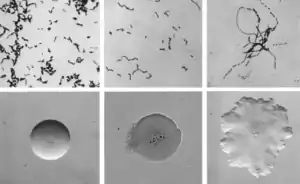Erysipeloid
In humans, Erysipelothrix rhusiopathiae infections most commonly present in a mild cutaneous form known as erysipeloid[1] or fish poisoning.[2] E. rhusiopathiae can cause an indolent cellulitis, more commonly in individuals who handle fish and raw meat.[3] Erysipelothrix rhusiopathiae also causes Swine Erysipelas. It is common in domestic pigs and can be transmitted to humans who work with swine. It gains entry typically by abrasions in the hand. Bacteremia and endocarditis are uncommon but serious sequelae.[4][5] Due to the rarity of reported human cases, E. rhusiopathiae infections are frequently misidentified at presentation.[1]
| Erysipeloid | |
|---|---|
 | |
| Cellular and colonial morphology of Erysipelothrix rhusiopathiae | |
| Pronunciation |
|
| Specialty | Infectious diseases |
Diagnosis
Violaceous swelling with severe pain but without pus (Which differentiates from pus forming streptococcal and staphylococcal erysipelas)
Erysipeloid of Rosenbach
| Erysipeloid | |
|---|---|
| Specialty | Dermatology |
Erysipeloid of Rosenbach is a cutaneous condition most frequently characterized by a purplish marginated swelling on the hands.[6]: 264 The eponym Rosenbach's disease is in reference to the milder type of the condition and is named after Friedrich Julius Rosenbach.[7] Early work on the condition in US fishermen was carried out by Klaunders and colleagues.[8]
Treatment
The treatment of choice is a single dose of benzathine benzylpenicillin given by intramuscular injection, or a five-day to one-week course of either oral penicillin or intramuscular procaine benzylpenicillin.[9] Erythromycin or doxycycline may be given instead to people who are allergic to penicillin. E. rhusiopathiae is intrinsically resistant to vancomycin.[9]
See also
References
- Brooke C, Riley T (1999). "Erysipelothrix rhusiopat: bacteriology, epidemiology and clinical manifestations of an occupational pathogen". J Med Microbiol. 48 (9): 789–99. doi:10.1099/00222615-48-9-789. PMID 10482289.
- "THE SHIP CAPTAIN'S MEDICAL GUIDE" (PDF). p. 190.
- Lehane L, Rawlin G (2000). "Topically acquired bacterial zoonoses from fish: a review". Med J Aust. 173 (5): 256–9. doi:10.5694/j.1326-5377.2000.tb125632.x. PMID 11130351.
- Brouqui P, Raoult D (2001). "Endocarditis due to rare and fastidious bacteria". Clin Microbiol Rev. 14 (1): 177–207. doi:10.1128/CMR.14.1.177-207.2001. PMC 88969. PMID 11148009.
- Nassar I, de la Llana R, Garrido P, Martinez-Sanz R (2005). "Mitro-aortic infective endocarditis produced by Erysipelothrix rhusiopathiae: case report and review of the literature". J Heart Valve Dis. 14 (3): 320–4. PMID 15974525.
- James, William D.; Berger, Timothy G.; et al. (2006). Andrews' Diseases of the Skin: clinical Dermatology. Saunders Elsevier. ISBN 0-7216-2921-0.
- Rosenbach's disease at Who Named It?
- Klauder, Joseph V.; Righter, Linwood L.; Harkins, Malcolm J. (1926). "A distinctive and severe form of erysipeloid among fish handlers". Archives of dermatology and syphilology. 14: 662–678.
- Vinetz J (October 4, 2007). "Erysipelothrix rhusiopathiae". Point-of-Care Information Technology ABX Guide. Johns Hopkins University. Archived from the original on June 7, 2008. Retrieved March 10, 2009. Retrieved on October 28, 2008. Freely available with registration.